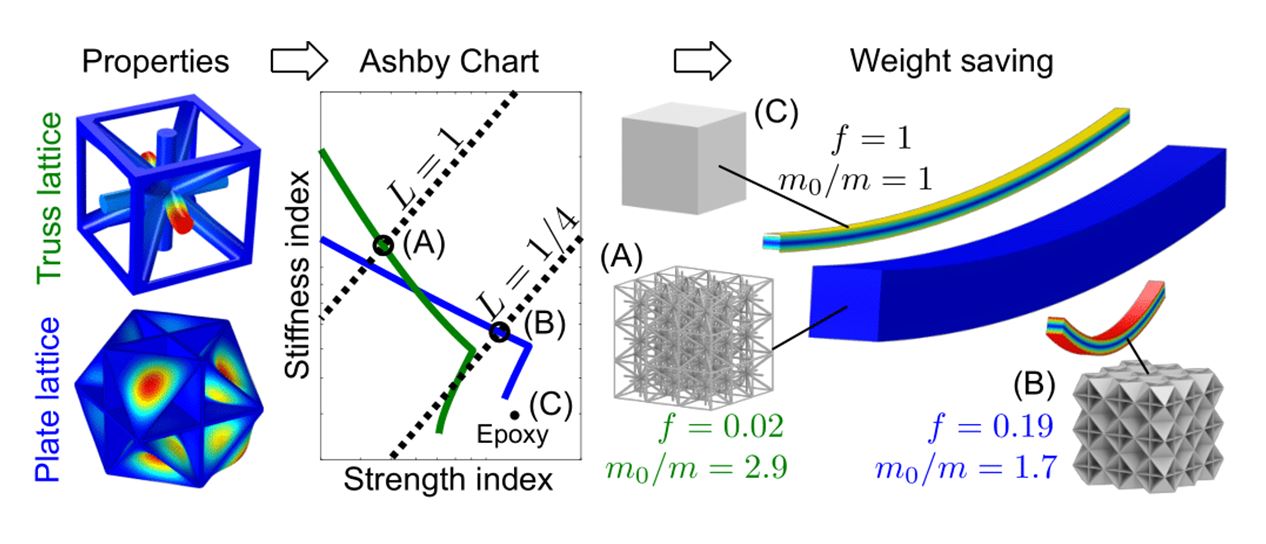Video Article Open Access
On the Competition for Ultimately Stiff and Strong Architected Materials
Morten N. Andersen*, Fengwen Wang, Ole Sigmund
Technical University of Denmark - Department of Mechanical Engineering, Solid Mechanics
Vid. Proc. Adv. Mater., Volume 2, Article ID 2021-02149 (2021)
DOI: 10.5185/vpoam.2021.02149
Publication Date (Web): 07 Apr 2021
Copyright © IAAM
Graphical Abstract

Abstract
Advances in manufacturing techniques may now realize virtually any imaginable microstructures, paving the way for architected materials with properties beyond those found in nature. This has lead to a quest for closing gaps in property space within a wide range of physical disciplines by carefully designed metamaterials. Development of mechanical metamaterials has gone from open, easily manufacturable truss lattice structures to more challenging closed-wall, plate lattice structures with stiffness close to theoretical bounds. However, the quest for optimally stiff and strong materials is complex. Plate lattice structures have higher stiffness and (yield) strength but are prone to buckling at low volume fractions. Hence here, truss lattice structures may still be optimal. To make things even more complicated, opening for hollow lattices or structural hierarchy, turns out to bring closed-walled microstructures back in competition. Based on analytical and numerical studies of common microstructures from the literature, we provide higher order interpolation schemes for their effective stiffness and (buckling) strength. These functions are based on analytical studies in the low volume fraction limit and extensive numerical studies involving buckling analysis where critical modes are found from searching the wave vector space determined by the irreducible Brillouin zone. However, the functions themselves are not sufficient to determine what microstructure is optimal for a given purpose. To this end we establish an Ashby multi-property scheme applied to a beam bending example, which can be used to select the optimal microstructure for a given application, based on manufacturing capabilities and base material. Our findings enable systematic weight saving via inverse techniques, simultaneously considering stiffness and strength and are relevant for all areas requiring weight-efficient structures, such as aerospace, automotive, civil engineering and sport equipment. Our finding will also help to determine optimal in-fill types for saving weight and preserving stiffness and strength in additive manufacturing applications. Furthermore, the provided interpolation schemes may also be used to account for microstructural yield and buckling in multiscale design optimization schemes.
Keywords
Metamaterials; microstructural buckling; instability; floquet-bloch; hierarchy.
Acknowledgement
We acknowledge the financial support from the Villum Investigator Project InnoTop. We further acknowledge valuable discussions with Yiqiang Wang regarding add-up models and Niels Aage regarding finite element modelling.
References
- MN Andersen, F. Wang & O. Sigmund. On the competition for ultimately stiff and strong architected materials. Materials & Design, 109356 (2020).
Biography
Morten N. Andersen
PhD Student: 2018 – Present
Technical University of Denmark
PhD. Project: Analysis of metamaterials with focus on buckling stability.
Publications:
On the competition for ultimately stiff and strong architected materials
https://www.sciencedirect.com/science/article/pii/S0264127520308923
M.Sc. in Mechanical Engineering: 2015-2017
Aarhus University
Master thesis: Topology optimization of compliant mechanisms.
B.Sc. in Mechanical Engineering: 2012-2015
Aarhus University
Bachelor thesis: Stress constrained topology optimization of nacelle skeleton.
Video Proceedings of Advanced Materials

Upcoming Congress



